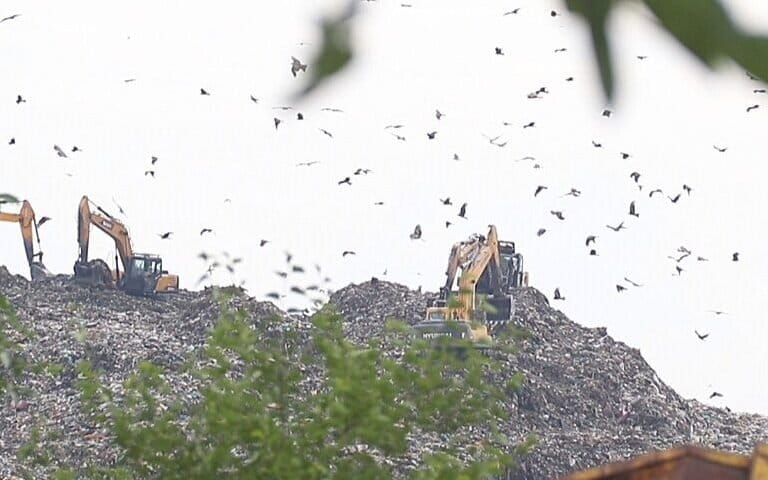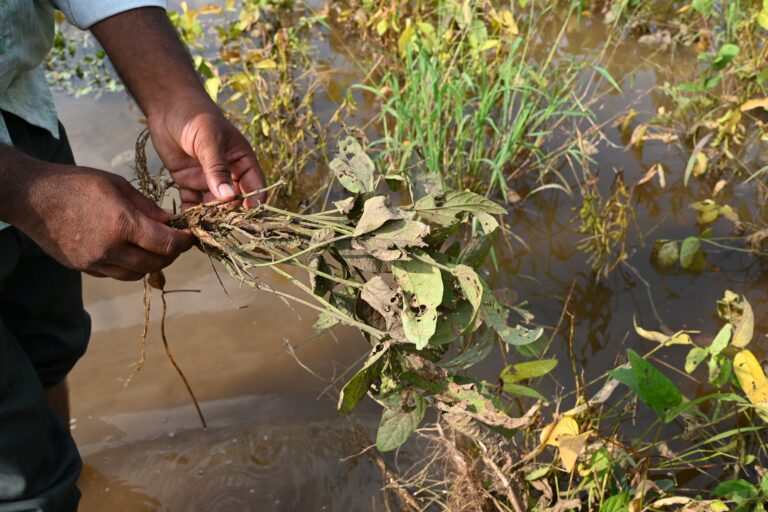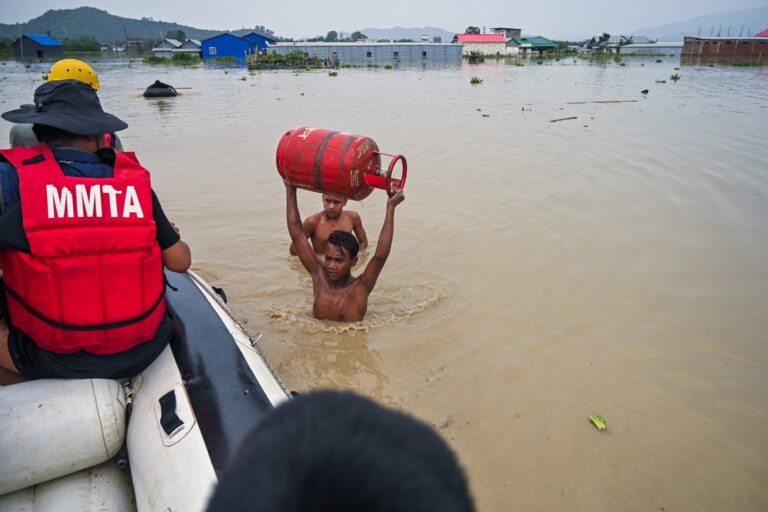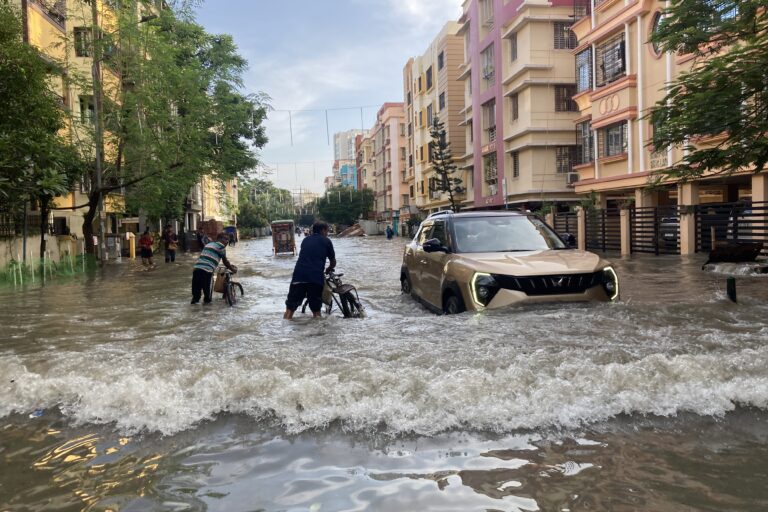- In November 2018, a study by the National Centre for Earth Science Studies showed that 60 percent of Kerala’s coastline is under erosion. It underlined that coastal development in the form of urbanisation, tourism, and “unscientific shoreline protection methods” has led to the coastline becoming unstable.
- Chellanam, a coastal village in central Kerala, has been facing the brunt of an increasingly erratic monsoon, floods, and cyclones. The low lying region gets inundated with seawater, and waves crash into a dilapidated seawall sending stones flying into homes.
- Shanghumugham, another coastal village in south Kerala is rapidly losing the beach to erosion. Fishers are losing land to the sea, affecting their homes and livelihood.
- In November 2021, the National Green Tribunal, southern zone, passed an order asking the states of Kerala, Tamil Nadu, Andhra Pradesh, Puducherry and Karnataka to come up with a shoreline assessment plan that provides a permanent solution for protecting the coast and the fishing communities. In April 2022, the NGT ordered the states to stall the construction of all hard structures across India’s coastline and recommended to state governments to come up with more eco-friendly solutions.
At 5 p.m. on February 10, at least 30 residents of Chellanam, a coastal village near Kochi in central Kerala, gathered on the side of the village road. The group was a motley of men and women of ages ranging from 40 to 75 — fishers, fishworkers, fish sellers, boat owners, and homeowners. They had set up a temporary shelter with bamboo, tarpaulin and bright green plastic chairs. Two speakers and a mic were also arranged. A huge banner with their cause and demands, and a whiteboard stating the day of protest – 837.
The group, part of a local non-profit forum Kochi Chellanam Janakeeya Vedi, were protesting the loss of their homes and livelihoods to coastal erosion and demanding that the government take proper action to protect their coastline. Their protest in Chellanam began on October 28, 2019, shortly after the village started experiencing severe erosion, and continues till date.
Chellanam is just one of the many villages affected by coastal erosion in the southern Indian coastal state. In November 2018, the National Centre for Earth Science Studies (NCESS) published a shoreline assessment study for southwest India. The study analysed the 1968-2014 period using multi-dated shoreline images and Survey of India (SOI) topographic charts. The analysis revealed that almost 60 percent of Kerala’s coastline is eroding. Apart from seal level rise, anthropogenic factors are a leading cause for an irreversible loss of land.

Coastal erosion and factors leading to damage
Kerala’s 590-kilometre long coastline, extending from Poovar in Thiruvananthapuram in the south till Thalapadi in Kasargod in the north is a dynamic coastal stretch. It lies sandwiched between the Arabian Sea on the west and the Western Ghats on the east. Its coast is intercepted by 41 rivers that originate from the Western Ghats and flow into the Arabian Sea through inlets that are connected to the sea via estuaries/lagoons.
Coastal erosion is the wearing away of the land by the sea. It is a long-term removal of sediment along the coastline. On dynamic shorelines, coastal erosion is a seasonal process. The littoral current is a combination of longshore currents that flow parallel to the shore and cross-shore currents that flow onshore-offshore. These currents transport sediment in both the directions and the beaches recede and accrete seasonally.
Kerala has three distinct seasons – pre-monsoon from February to May, the southwest monsoon from June to September and the northwest post-monsoon from October to January. The longshore currents generally flow north to south during the monsoon and in the opposite direction in other seasons. One of the primary reasons for erosion is the influence of monsoonal and non-monsoonal waves. The beaches, after being subjected to seasonal erosion, are capable of completely regaining their original shape.
But, over the years, as the NCESS study indicates, coastal development in the form of urbanisation, tourism, and “unscientific shoreline protection methods” has led to the coastline becoming unstable. Anthropogenic activities such as the construction of hard structures (breakwaters, seawalls, groynes), dredging of channels, beach/river sand mining, and damming of rivers have a negative impact on the coast. They obstruct the natural flow of the water, cause a shortage of sediment supply, and cause erosion on one part of the land and accretion on another part.

“Imagine a river of sand is flowing in a particular direction, just like a river,” said K.V. Thomas, geographer and former scientist and group head at NCESS, and former Dean, Kerala University of Fisheries and Ocean Studies, Kochi.
When one has structures protruding from the shore — breakwaters, harbours, jetties, or groynes — they block the natural flow of the sand, just like a dam blocks a river.
“When we intervene with the natural flow of sand on the up-drift side, the sediment gets blocked on that side. The down-drift side, where the sand is supposed to flow, now experiences scarcity. Thus, there is erosion on the down-drift side, and deposition on the up-drift side,” he explained. Once this displacement happens, there is no scope of sand coming back, as it is blocked by the structure. The erosion is irreversible.
Today, Kerala’s coast is dotted with one major port at Kochi, four intermediate ports at Thiruvananthapuram, Alappuzha, Kozhikode, Thalassery, an upcoming international port at Vizhinjam, 25 fishing harbours and breakwaters, and 106 groynes. Of the entire coastline, about 310 km is an artificial coast. An artificial coast is an eroding coast that is managed by man-made structures — seawalls running parallel to the shore, and groynes built perpendicular to the shoreline.
This is why fishers say that the “beaches would always come back. But not anymore.”

Read more: Keeping alive a mangrove conservationist’s legacy to protect Kerala coast
The eroding coast of Chellanam
Chellanam is a narrow strip of low-lying land nestled between the Arabian sea and the backwaters of Vembanad Lake, the largest freshwater lake in Asia in the Ernakulam district of central Kerala. Cochin port lies to its north. The 17.5 km coastline has a harbour and a coastline that is partially covered with a seawall in dilapidated condition. Approximately 16,000 families live in the 812-hectare area. Large stretches of revenue land and property owned by the local community have been eroded over a period of 40-50 years in this area. Hundreds of families have lost their homes.
Sixty-two-year-old Filomena Joseph lives with her husband and two children in the Bazar ward of Chellanam. Her home, a broken, small pucca structure, lies barely 50 metres from the Arabian Sea; a wall of rocks separates it from the lashing waves. Nearly a year has passed since Cyclone Tauktae tore through the west coast. Huge waves overtopped the seawall, inundating the Chellanam village with floods. Some waves smashed through the seawall, sending stones flying into people’s homes. The Bazar ward, one of the worst affected parts of Chellanam, still looks like a disaster site. Nearly every house is either broken or filled with sand.
The row of houses next to Filomena’s are broken structures. They are the first in line, facing the sea, with the rocks between them. The beach that existed between the seawall and the sea is long gone. “Last monsoon, the waves were so big and strong, they crashed into the seawall, and the stones flew into people’s homes,” said Mary Jugunu, a resident of Chellanam and also the local translator for Mongabay-India.
“The depth is too high now. As you enter into the water, you will just fall,” she continued to explain. In her childhood, there used to be a beach in front of the seawall. In the presence of a beach, the waves break on the sand, and the energy gets absorbed, thus softening the waves. But now, there is no place for the waves to crash because there is no beach. The sand is gone, and the depth is so high that the waves directly crash into the seawall.
It is not that the waves themselves have become stronger, she added. It is just that they crash more heavily because of the high depth.
Chellanam, a coastal village faces the brunt of an increasingly erratic monsoon, floods, and cyclones. The low-lying region gets inundated with seawater, and waves crash into a dilapidated seawall sending stones flying into homes. All photos by Supriya Vohra/Mongabay.
The disappearing beach of Shanghumugham
The sea by the beach of Shanghumugham, a fishing village near Trivandrum in south Kerala has layers of three distinct colours – a muddy brown near the shore, a teal, and a deep blue. The muddy brown is new, said Ajith Shanghumugham, a fisher, chef and activist from the village. “The sea has come closer. The beach used to stretch for miles and miles, and now it is barely 25-30 metres,” he said. A road running parallel to the shore, linking the beach to the city airport has been entirely damaged due to coastal erosion, making it tough for people to complete the last mile to the airport.
Fishing with kambavala, a large shore seine net requires up to 40 people at a time, and requires the fishers to hold the net from the sides, placing it near the shore. It is one of the oldest traditional fishing methods in south Kerala, and one that employs elderly fishers as well, as they don’t have to go into the sea. The net needs large swathes of land to spread out on. The shrinking beach has made it difficult for fishers to keep their nets, boats and equipment.

Many have even lost their homes to the sea, and have been shifted to relief camps.
On July 23, 2019, Celine Gerard’s home in Shanghumugham collapsed. It was a regular monsoon day. Rain thrashed. Waves crashed. “The waves came and took sand below my home and it just entirely caved in. No warning,” said Gerard. She now lives with thirty other refugees in a relief camp in Valiathura, a neighbouring village that is also facing the brunt of erosion. The camp is built of shipping containers, with 5ftx5ft cubicles fitting in 14 families, one kitchen, and two bathrooms.
The women want their homes back. Grief is a constant factor in their lives. They neither blame the sea nor the cyclone or the floods. They squarely blame the upcoming private port in Vizhinjam, about 20 km away.

What is causing the large scale erosion?
While studies have proved that hard structures along the coastline cause irreversible coastal erosion, scientists insist that more site-specific studies are needed to understand the precise reasons, as the geomorphology of the coastline is different for each location.
In February 2022, Rafeeque M.K., a scientist studying coastal morphologies at NCESS presented a paper during the Oceans 2022 conference in Chennai. The draft, yet to be published, is titled Functional Performance of Coastal Protection Structures. Using scientific analysis and focus group discussions with indigenous fishers, his paper reveals that the shoreline trend analysis of the Trivandrum coast from 1968 to 2021 shows that 81 percent of the coastline is affected by coastal erosion. While the paper does not make any specific mentions about the Vizhinjam port, it does say that hard structures such as breakwaters, seawalls and promenades, and activities such as dredging cause irreversible erosion of the beaches. A 3.1 km breakwater is currently under construction at the port.

In Chellanam, central Kerala, the 2018 NCESS study shows that the region south of Cochin inlet (where Chellanam lies) has been under erosion for years. While activists and fishers blame the continuous dredging of the Cochin port for the coastal erosion, scientists also say that the renovated harbour breakwater could be increasing the rate of erosion. They also blame dredging.
For a port to maintain its shipping channel, it needs continuous dredging.
“Dredging is essentially the removal of sand from a beach,” said Thomas. “And they started dredging the tidal inlet (of Cochin) to deepen the channel, which changed the inlet dynamics and eventually the sediment dynamic,” he explained. The sand recharges the coast, it was deposited over thousands of years, and when we dredge it we are removing it. “The sediment is food for the coast and we are making it hungry,” he added.
And the first line of impact is the fishing communities that live on these stretches.

Read more: How climate change is taking a toll on livelihoods of small-scale fishers in Kerala
What is the government doing?
In December 2021, the Kerala government, through funding received by the Kerala Infrastructure Investment Fund Board, launched a Rs. 344 crore (Rs. 3.44 billion) project to build a seawall at Chellanam using tetrapods and rubble. The contract was given to Urangular Labour Contract Cooperative Society. The work is ongoing.
In Shanghumugham, a 350-metre long diaphragm wall is under construction to protect the airport road. A diaphragm wall is a continuous reinforced concrete wall constructed in the ground and acts as a retaining wall. The project was allotted Rs 6.39 crore (Rs. 63.9 million) under the Rebuild Kerala Initiative, a state government project to restore and rebuild Kerala after the 2018 floods. The work, here too, is ongoing.
This year, as part of their 2022-2023 budget, the government has allocated Rs 333 crore (Rs. 3.33 billion) for the coastal protection of the overall state.
But the government is keen on seawalls even when science has established that they are counter-effective. Seawalls have a long drawn history in Kerala, with the first one being constructed in 1890, south of Varkala cliff in Trivandrum in the southern district of the state. “The purpose of that seawall was to protect a canal that was being constructed at the time, not the coastline,” explained Thomas of NCESS.
Ever since, seawalls have been the go-to solution for any kind of protective measure. The erosion of the beach from the front of the seawall, explains Thomas, is often a result of the seawall being placed on the wrong site. “This is a micro-tidal and a high energy coast. A seawall cannot be the first option for protecting the coast in such a situation,” he said. “Once the waves hit the seawall, they will take the sand away, and over time the sediment will disappear from the spot. The waves will continue to get higher, and eventually overtop and break into the seawall.”

But, Thomas stressed that things are slowly changing. “Seawalls must only be used in dire emergencies, and the government is slowly understanding that,” he said.
In November 2021, the National Green Tribunal, southern zone, released an order demanding a shoreline assessment plan from Kerala, Tamil Nadu, Andhra Pradesh, Puducherry and Karnataka to devise a strategy to mitigate the problem of coastal erosion. The order emphasised that it has been proved that the construction of a seawall along the coastal zone is not a permanent measure for protecting the coast and each time state governments end up spending a huge amount on their construction. “It is high time for the coastal states to find out some scientific measures as to how this can be resolved so as to protect the coastal region…without affecting the persons who are depending on the sea for their livelihood,” the order stated.
Recently, on April 11, 2022, the NGT passed an order to stall the construction of all hard structures across India’s coastline, recommending to state governments to explore more eco-friendly solutions.
Queries sent to the Kerala state government regarding the seawall projects and shoreline assessment plans were unanswered at the time of publishing.
What about those who have lost their homes to the sea?
For rehabilitation and compensation, the state government has offered financial assistance with the “Punargeham project” which offers people Rs. 600,000 to buy new land and Rs. 400,000 to construct a home. The scheme is meant to rehabilitate 18,685 families living within 50-metre of the high tide line. Many people have found faults with the compensation because land prices are “too high” and they “do not want to move away from the sea.” On April 1, 2022, the fair value of land in the state went up by 220 percent from the time it was fixed in 2010.
“We also don’t get any loan from the banks because all of these coastal areas are vulnerable and no bank wants to take a risk. They have pushed us to the brink,” said 65-year-old Joseph, a fisherman whose home was completely destroyed in the cyclone last year. While some are suffering from the pain of losing their homes, residents like Filomena, who have parts of their houses intact, live by the sea with a sense of foreboding.
“We live in fear of the sea,” shared Filomena, whose front rooms are reduced to rubble, the switchboard is gone, the windows are broken, and all electrical appliances are rotting thanks to the seepage of seawater. She had 11 coconut trees, out of which seven were uprooted last year during the cyclone. She used a bit of her land to grow vegetables but she notes that saline water destroyed that livelihood. Her husband, a fisher, rarely goes to work because of dwindling fishing days thanks to bad weather.
But the sea is her home. “This is my homeland. This is my kadalamma (mother sea). I cannot leave this place. Our government needs to do better,” she said.
The sea visible through a house damaged by a cyclone and flying stones from a seawall. Photo by Supriya Vohra/Mongabay.
Banner image: A house damaged by Cyclone Tauktae and coastal erosion in Chellanam. Photo by Supriya Vohra/Mongabay.



















